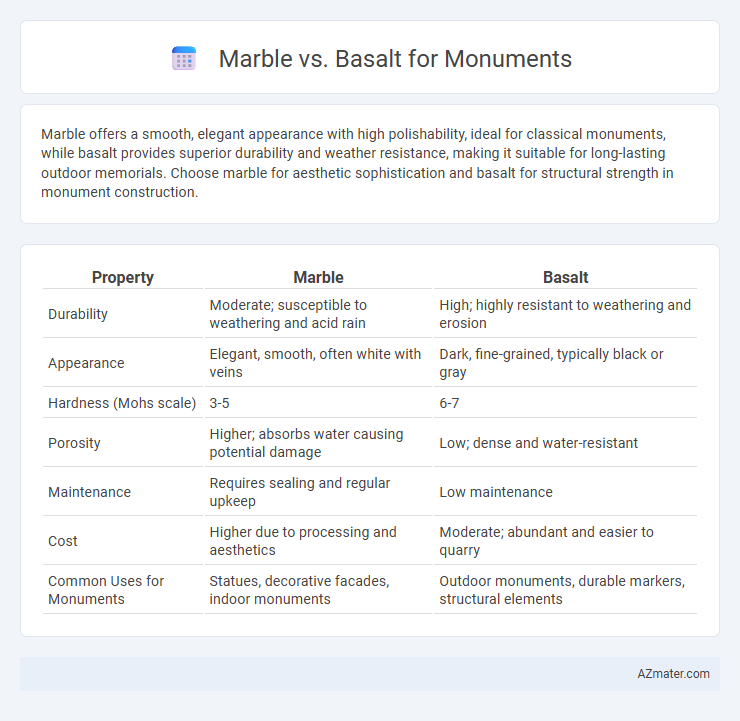Marble offers a smooth, elegant appearance with high polishability, ideal for classical monuments, while basalt provides superior durability and weather resistance, making it suitable for long-lasting outdoor memorials. Choose marble for aesthetic sophistication and basalt for structural strength in monument construction.
Table of Comparison
| Property | Marble | Basalt |
|---|---|---|
| Durability | Moderate; susceptible to weathering and acid rain | High; highly resistant to weathering and erosion |
| Appearance | Elegant, smooth, often white with veins | Dark, fine-grained, typically black or gray |
| Hardness (Mohs scale) | 3-5 | 6-7 |
| Porosity | Higher; absorbs water causing potential damage | Low; dense and water-resistant |
| Maintenance | Requires sealing and regular upkeep | Low maintenance |
| Cost | Higher due to processing and aesthetics | Moderate; abundant and easier to quarry |
| Common Uses for Monuments | Statues, decorative facades, indoor monuments | Outdoor monuments, durable markers, structural elements |
Introduction to Marble and Basalt
Marble, a metamorphic rock primarily composed of recrystallized carbonate minerals like calcite, is renowned for its smooth texture and elegant appearance, making it a popular choice for monuments and sculptures. Basalt, an igneous rock formed from the rapid cooling of basaltic lava, is characterized by its dense, fine-grained structure and exceptional durability, often used in monuments requiring high resistance to weathering. Both stones offer distinct aesthetic and physical properties, influencing their selection based on the monument's desired longevity and visual impact.
Geological Origins of Marble and Basalt
Marble originates from the metamorphism of limestone or dolomite, characterized by recrystallized carbonate minerals, primarily calcite or dolomite, resulting in its distinctive crystalline texture and often vibrant veining. Basalt is an igneous rock formed from the rapid cooling of low-viscosity lava rich in magnesium and iron at the Earth's surface, creating a fine-grained, dense, and durable stone. The contrasting geological origins give marble its elegance and susceptibility to weathering, while basalt provides exceptional strength and resistance, making each suitable for different monument applications.
Physical Properties Comparison
Marble exhibits a softer texture with a Mohs hardness of around 3-4, making it more susceptible to scratching and weathering compared to basalt, which has a hardness of 6-7 and offers superior durability. Basalt's dense, fine-grained structure provides higher compressive strength, typically around 100-300 MPa, suitable for heavy load-bearing monuments, whereas marble's compressive strength ranges between 70-140 MPa. Porosity in marble is higher, leading to increased water absorption and potential staining, while basalt's low porosity enhances resistance to environmental degradation and chemical weathering.
Aesthetic Appeal and Color Variations
Marble offers a luxurious aesthetic with its smooth, polished surface and wide range of color variations, including classic whites, greens, pinks, and blacks, making it ideal for monuments that demand elegance. Basalt provides a more subdued, matte finish with deep blacks and grays, emphasizing durability and a modern, minimalist appeal. The color variations in marble often feature intricate veining, while basalt's uniform texture supports a sleek, contemporary look, influencing monument design choices based on visual impact and tonal nuance.
Durability and Weather Resistance
Marble offers a classic aesthetic with moderate durability but is more susceptible to weathering and acid rain due to its calcium carbonate composition. Basalt demonstrates superior durability and weather resistance, featuring high density and low porosity that make it less prone to erosion, chipping, and discoloration over time. Monuments crafted from basalt maintain structural integrity longer in harsh climates, making basalt a preferred choice for long-lasting outdoor memorials.
Workability and Sculpting Potential
Marble offers superior workability and sculpting potential due to its fine grain and uniform texture, allowing artists to achieve intricate details and smooth finishes in monuments. Basalt, being a dense and hard volcanic rock, poses challenges in carving but provides exceptional durability and strength, making it suitable for robust structures. The choice between marble and basalt depends on balancing the desired artistic detail with long-term structural resilience.
Cost Analysis: Marble vs Basalt
Marble generally incurs higher costs compared to basalt due to its extraction, transportation, and processing complexities, as well as its popularity in luxury monuments. Basalt offers a more cost-effective alternative with lower quarrying expenses and greater durability, reducing long-term maintenance costs. When choosing between marble and basalt for monuments, budget considerations often favor basalt for its affordability and resilience without compromising aesthetic appeal.
Historical Use in Monument Creation
Marble has been historically favored for monuments due to its fine grain, durability, and ability to be intricately carved, evidenced by iconic sculptures like Michelangelo's David and classical Greek temples. Basalt, with its dense, hard composition, was prominently used in ancient times for robust monuments, such as Egyptian obelisks and the Aztec calendar stone, prized for its longevity and resistance to weathering. The choice between marble and basalt often reflected cultural preferences and environmental considerations, with marble symbolizing elegance and basalt embodying strength.
Maintenance and Longevity
Marble requires regular sealing and cleaning to prevent staining and weathering, making its maintenance more intensive compared to basalt. Basalt offers exceptional durability and resistance to erosion, requiring minimal upkeep and maintaining its structural integrity over extended periods. For monuments, basalt's longevity and low maintenance demands make it a superior choice, especially in harsh environmental conditions.
Choosing the Right Stone for Your Monument
Marble offers a classic, elegant appearance with smooth, veined patterns that symbolize purity and dignity, making it ideal for monuments meant to convey timeless beauty. Basalt provides exceptional durability and weather resistance due to its dense, fine-grained texture, ensuring long-lasting strength in outdoor environments. Selecting the right stone depends on balancing aesthetic preferences with climate conditions, maintenance requirements, and desired longevity for your monument.

Infographic: Marble vs Basalt for Monument
 azmater.com
azmater.com